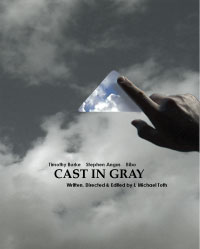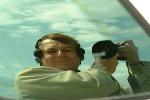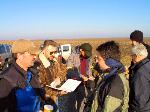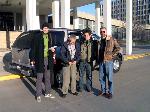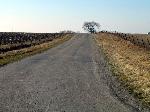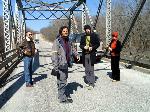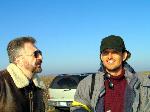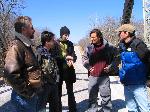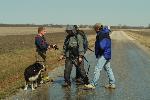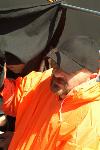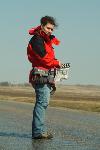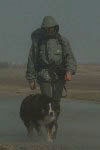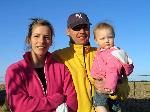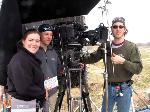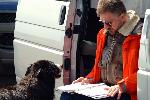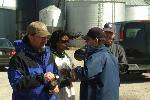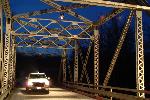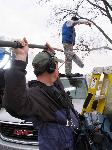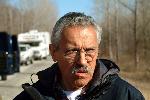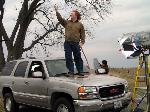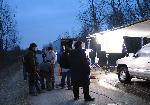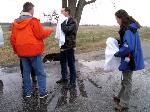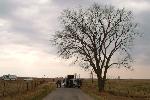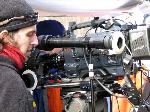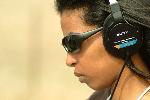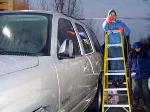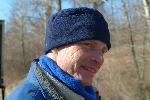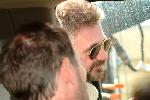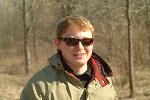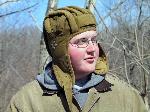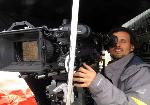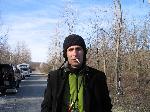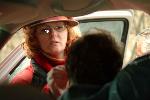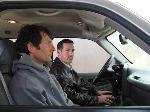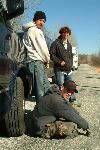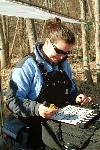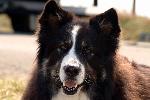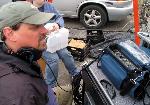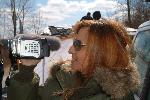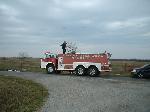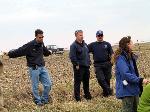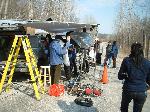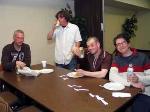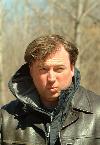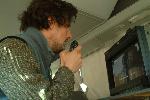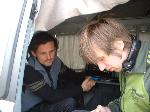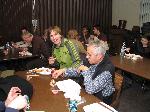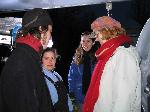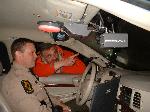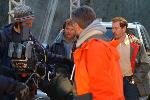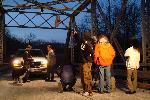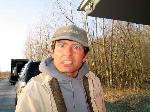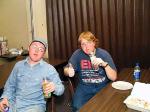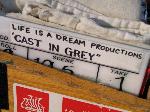Production Stills (Click on Image to Enlarge)
Photos by Oto Ekres
Oto Ekres (self portrait)
Location scouting
Desolate road location and an interesting oak tree
The crew arrives at Olsen Hall on the campus of WIU
Scouting the bridge
Director Michael Toth and Cinematographer Sasha Rendulic
Working out the rain effects
2nd AC Amanda Diller
Director Michael Toth
Stephen and Bibo
Michael discusses the next scene with Bibo
Uncorking the champagne
The bridge scene
Tom Beach with the boom
Discussing a shot on the bridge
Grip Intern Doug Hall
Irena Stepic Rendulic
Production Coordinator Makkida Asfaw
Production Asst. Michael Baumann
Key Production Asst. Nathan Locke
Gaffer Jim Andre
Michael Toth directing actor Timothy Burke
Sasha frames a shot
Costume Designer Natasha Djukich
Actors Stephen Angus and Tim Burke
2nd AC Amanda Diller
1st AD Daniel Rucci
Bibo with a happy smile
Sound Mixer Tom Beach at the sound cart
Sasha and Ratko
Sasha checking the shot
Shooting as the sun sets
The crew sets up on location
outside of Macomb, Illinois
Development – Winter 2003. Cast In Gray was born out of a dream Michael had one night and by our overwhelming desire to put our slate of films we had been developing over the last three years in play. I had witnessed the brilliance of Michael’s writing skills and was anticipating our first production with great excitement. Michael set to writing Cast In Gray based on the dream he’d had of a hitchhiker and his dog wandering about the countryside. It took the better part of two months to ready the screenplay. Of course, in the process Michael had a feature film in mind, which he is currently finishing writing. We were sort of following the approach Jim Jarmusch took with Strangers In Paradise – convinced that this short film would be a first step in the making of a full length feature version of Cast In Gray. The story was designed to stand on its own as a short film, but would be expanded upon to create a feature film.
January 2004. As Michael was writing the script, he had two actors in mind to play the leads. Michael had known Stephen Angus for some time and had always been impressed with his stage work. It came as a bonus that Stephen owned a dog that had some acting experience. Thus, Michael wrote the part of The Man with the Dog for Stephen and, of course, Bibo would play The Dog. I had introduced Michael to an actor friend of mine from Connecticut, Timothy Burke, to Michael a year ago, and Michael immediately took an interest in Tim and his acting ability. After several conversations, Michael sensed Tim’s personality and background would form the character of The Man. Michael and I had become familiar with digital filmmaking over the last few years, attending conferences and seeing the latest technology applied to feature filmmaking. We were confident in the medium for our project but both agreed if we were to go digital it had to be high-definition (HD) to get a film look. With that, we knew we had to find a cinematographer with HD experience that could achieve a film look.
February 2004. With the screenplay finished and the cast in place, we set about scouting for locations outside of Chicago. The script called for a desolate countryside where our characters would be stranded in a day-long rainstorm. To achieve the gray monotone look that Michael wanted, we knew we had to shoot the film before spring arrived. Midwest late winter is usually gray and rainy with the approach of spring. We had initially targeted a late February shoot so long as the winter cold and snow abated and we would have a window of mild weather. This was important given our need for rain as a key element of the story. However, we knew if we were lucky enough to get some gray days and rain, we would still need to have rain effects at the ready. The question was how to achieve this on a very tight budget. Suburban Chicago failed to give us the locations we desired. One day on a scout I began to think of the country roads outside rural Macomb, Illinois, where I grew up. In my mind I could envision numerous locations that would be perfect. The only problem was it was 250 miles southwest of Chicago. How could we afford a location shoot? To find out, I developed a list of production elements that would be required and called my long time friend, Frank Herbert, who lives in Macomb, to see what he could get from the locals (accommodations, food, PA’s, rain effects, etc.). It took Frank about 24 hours to respond with ideas about how to get what we need. I was encouraged and made a trip to Macomb. We worked out a deal with the local university (Western Illinois University) to accommodate and feed us, and they also got some students from the theater and broadcast departments to serve as PA’s.
Frank and I made a stop by the Macomb Fire Department to get some advice on
building a multi-head water pumping system for rain effects. After we told them about our movie, a few of the firefighters stepped forward and said they could do
it. They pulled their trucks into the parking lot and proceeded to make rain – lots of it. We loved it – and the enthusiasm of the firefighters - and got the mayor to approve the use of the fire department. With all of the support the town of Macomb was offering to us, it seemed that we would get the best bang for our buck there, plus a laid back small town environment for our cast and crew. It took
a day of location scouting to find a number of possibilities. After going over the location pictures with Michael and Production Designer Bata Radovanovic, we made the decision to go ahead with the shoot in Macomb. We began to assemble the crew, who agreed to work on deferral, and targeted February 28 as
our start date – weather permitting. As we moved into pre-production, we all began to watch the weather forecasts. We recently had a snow storm, and the snow on the ground wasn’t melting due to low temperatures. Giving that we were going to be spraying water all over the set and the actors, we knew we had to have +40 degree temperatures and overcast conditions.
February 23, 2004. There’s still snow on the ground and it’s cold. The forecast shows no improvement and we are forced to move the shoot back two weeks. Despite this setback, we got the good news that cinematographer Sasha Rendulic had agreed to shoot the film for us. Sasha was very passionate about the project based on his liking of the screenplay and the overall production design that he would photograph beautifully. We were elated with his decision. We were even more encouraged by Sasha’s understanding of the low budget nature of the project. He would not have all the crew and equipment a seasoned cinematographer was used to, but he pointed out that he loved the project and would revert to his experience early in his career when such conditions required being creative with what you have to work. He also knew the flexibility of the Varicam HD camera and was confident to get the look Michael wanted.
March 5, 2004. With the rest of the crew in place, we had only a short time for pre-production. The crew worked feverishly to get ready for the shoot in Macomb. With the snow melting and the forecast looking towards rain and mild weather, we settled on March 20 as our start date – weather permitting.
March 16, 2004. As final preparations are being made to begin production in Macomb, we continue to nervously watch the weather reports, which were for rain next week. Midwest weather this time of year can’t be relied upon, but we hoped for the best (or worst weather we could find).
March 18, 2004. The tech crew arrived at 4:00pm and checked into Olsen Hall Conference Center on the campus of Western Illinois University. After everyone unpacked we had dinner at Aurelios in downtown Macomb and discussed our plan for Friday, basically to lock in locations.
March 19, 2004, The tech crew rose for a 6:30am call to check out our locations for
the shoot. We saw several locations that we had previously identified, largely south of town, and discovered a few other possibilities. St. Francis Blacktop running
straight south from the town would provide the length and look for the Leonard Cohen scene. From there we looked at Camp Creek Cemetery area, the leading location for most of our exteriors including the man's passing of the hitchhiker and his dog, the near miss with the semi and the place where they will be stranded in the rain. We found a wonderful truss bridge, the only one of its kind in McDonough County, to shoot the identity exchange scene. The bridge would be lit with a single light from the 20 foot girders above. A beautiful little creek passing below would be lit to get a nice shimmering of light off of the gentle rapids. After the group agreed on and locked our locations, we had lunch and prepared for camera tests when the camera and grip truck arrived. With the rush to prepare I got behind in my need to drive to Peoria to pick up our generator. I finally departed at 4pm. Fearing that the vendor will close for the weekend, I call the sales rep, Melanie Walringer. Fortunately I reach her on her cell phone and to my relief she arranges for an after hours pickup. I was received by Chad Pullen, a gregarious, very nice fellow that discovered that the ball on the hitch was the wrong size and needed to be cut off since it was welded. Chad struggled with that ball for an hour but got me fixed up. I returned to Macomb with the generator in tow and we all headed off to dinner. We had a production meeting from 8-10pm before getting to bed to rest for the 6am call.
March 20, 2004. Breakfast was served at 5:30am, after which we headed out at 6am to set up at the Camp Creek Cemetery location. The weather was looking good (overcast!), then the sun came out and the wind picked up on the prairie to 35 mph. Not the ideal conditions we wanted. Conditions persisted throughout the day, but we stayed the course and tried our best to get some coverage. Hats off (literally in this wind) to the grip crew for holding up the flags in the cold wind.
March 21, 2004. 6:30am call. We relocated to an alternative location given the forecast for sun and 15-20 mph wind and shot interior car scenes with the 20X20 silk. These scenes were long dialogue scenes and were shot using special effects for rain and overcast conditions. Great job by Bata and Jim Andre to get a subtle foggy window effect on the car windows. Sasha and Jim Andre worked with Joe to get a nice light and look. The actors were fantastic and we got some great performances. A successful day.
March 22, 2004. 6:30 am call. We spent another sunny day under the silk to mask the sun continuing finishing the middle part of the story involving long and very important dialogue scenes. Very challenging work for the actors, which they gave
Michael great performances. Shot masters of Bibo the dog. Great shots thanks to Ratko’s talents for dog growling to get Bibo to react with barking.
March 23, 2004. 6:30am call. We finished the interior car scenes under the silk with the sun persisting. Hoping for overcast conditions to get our exteriors, but it didn’t happen. At this point it will be tough to get all of our exterior coverage on Wednesday, our last shoot day. We went later than our 12-hour schedule, but the crew stayed on to finish the car interiors. Went out for burgers and beers.
arch 24, 2004. 8:30am call. We went to the Camp Creek location to work on scenes there. Clouds in the sky, but not enough to give us overcast conditions. Forecast for storms, but the clouds didn’t cover nicely until after lunch. At that point we worked fast to get exterior coverage. The crew did a great job with the setups. As dusk fell and our light faded, we cranked up the gain and captured some interesting images of the praying scene. The storm was coming upon us and we hope to get heavy rain to pack the camera in the rear of the SUV to get the Leonard Cohen scene. Unfortunately, as our schedule was coming to a close, the storm was skirting us to the West. Sasha, Daniel, Michael and Chris conferred about how we could get the Leonard Cohen scene in using rain effects provided by the Macomb Fire Department crew. After discussing several ideas, we decided to attempt to create the illusion of our SUV driving while standing still in the road. To do this, the SUV was positioned on the back of a slight rise in the road to take out the road that would be still. Ryan Holz applied a force of water over the SUV’s front to create the rain. Two Illinois State Police cruisers driven by Troopers Jon Dively and Dan Leezer were directed to pass by the SUV at 10 mph with their lights going. It worked beautifully. Can’t wait to see the dailies!
March 25, 2004. Travel day back to Chicago to regroup and address our lack of coverage forced upon us by the absence of overcast conditions. Driving back to Chicago we could only be excited about the great coverage we got and the challenge of finishing our location work to make this very exciting film.
April 9/10, 2004. After waiting until 5pm last night to make a call on the weather forecast and a trip back to Macomb for a few more days shoot, our production team hustled to gear up for the trip down state. Frank got us road closure for the bridge scene and lined up a backup water truck and pump for rain effects to step in for the firefighters (big thanks to local power farmer, David Murphy). We contracted a grip truck and crew out of Springfield, fortunately about 83 miles away. Everyone arrived at the hotel around 5pm and was on location to light the bridge scene at around 10pm. As this beautiful truss bridge was rigged in the middle of the countryside, we worked up the hill in the dark with portable lighting and rain effects to shoot some of the hitchhiking scenes with actor, Tim Burke and Bibo. The generator gave us some fits down on the bridge, but with the help of our gaffer, Jim Andre, we were able to power up the lighting scheme on the bridge, which looked great, thanks to grips Rick Unsbee, Tim Lynn and our PA’s. We shot the bridge scene and wrapped to birds chirping us towards another sunny day (fowled forecast once again) as we headed back to the hotel at 7am for some well-deserved sleep.
April 10, 2004. After sleep and a fortifying spaghetti dinner at Pagliai’s Pizza, the cast and crew headed back to the Camp Creek location south of Macomb to shoot some of the car exteriors and night driving scenes. Without natural rain, the Macomb Fire Department once again came through with some hard driving rain effects. We wrapped some great shots at around 9pm.
April 11, 2004. 8am call back at the Camp Creek location. We began with some of the exterior driving shots, again forced to create rain on this at least fortunately overcast day, although the sun played with us, storms moving north of us in a westerly direction. David Murphy came through with a surprise in his barn – an old electric utility truck with a 35 foot hydraulic crane and bucket. First AC Dave Wightman bravely operated the camera in the bucket to get us some high angles on the praying scenes. The added height and wider angles with the camera posed a challenge for the rain effects but the firefighters and David Murphy’s water truck with a garden hose attachment did the trick. We wrapped with the tow truck scene and had a night cap at Bruce Brown’s Chandler’s On The Park restaurant before a tired crew made the journey back to Chicago.
April 21, 2004. The weather reports have been totally unreliable. However, storms have moved into the Chicagoland area and it looks good for this evening, but sketchy tomorrow. We made the decision to get the last of our night shots, but as our chosen location in McHenry County was unavailable in the late evening, we were forced to come up with an alternative. A small crew met at director Michael Toth’s house and we headed out around 10pm looking for a remote location in the northern Chicago suburbs. With a short time table we made our way into a Cook County Forest Preserve about 6 miles from Michael’s house, which would suffice for the night’s shots. While camera operator Kurt Branstetter and First AC Dave Wightman were setting up the camera inside the SUV, curious onlookers began to mistake us for an Ocean’s 12 crew (shooting in Chicago). It turned out that the location we randomly chose was one of their locations for the next morning. It worked great for us as the local police mistook us for the Ocean’s 12 crew and left us alone for the evening. We got our shots and wrapped to a Bibo deer chase at around 6:30am greeted, of course by the Ocean’s 12 crew and several VIP limos arriving on their set.
May 1, 2004. The weather forecast for tomorrow calls for showers and overcast skies. Given the totally inaccurate forecasts to date, we were not about to rely on
natural rain to help us get interior driving shots in rain. As such, and to our great fortune, actor Stephen Angus is a very talented carpenter. Without a Hollywood budget for big rain effects (it would take several cranes, water tankers and other effects equipment) we devised a portable rain effects system that would be rigged to the SUV picture vehicle. A 65 gallon water tank placed in the back of the SUV (competing with camera and crew), a ½ HP water pump, garden hose with four shower head extensions and a portable generator mounted on the bumper (big thanks to Rodog) provided us with rain in the frame. Stephen built a wood frame-box-thing on top of the luggage rack of the SUV with four hose/head extensions that could be adjusted with some heavy duty clamps – extending out over the windshield or side window, giving the illusion of a rain storm (assuming its overcast!).
May 2, 2004. 6:00am call on location. After dodging the sun for most of the morning and afternoon, we achieved some critical shots at this beautiful McHenry County Glacial Park. Chief Dave Rudolph and the Richmond Fire Protection District firefighters and paramedics provided additional rain effects and were part of the accident scene toward the end of the day’s shoot. We wrapped at about 8pm and stopped off with the crew for some dinner, then the drive back to Chicago.May 4, 2004. Down-converted the last of our HD tapes at Zacuto Films in Chicago (kudos to Steve and Yens for their support). Thirteen hours of footage shot over our nine production days. Michael will log in the scenes and begin the edit. The footage looks great thanks to cinematographer Sasha Rendulic and the rest of the crew.
May 31, 2004. Michael has been working on the edit using Final Cut Pro (FCP). I looked at a sequence he has been working on and it looks great. Being Michael’s first time editing in FCP, there’s a learning curve, but he is progressing fantastically.
June 12, 2004. The edit is progressing and I am impressed with Michael’s aptitude working with FCP. He’s incorporated some visual and sound effects that are impressive. Quite a robust little system, and I am greatly encouraged. There are the obvious continuity issues to resolve, but Michael is handling them fine.
June 30, 2004. The film is coming together. Michael is working night and day to master the DVD for festival submission, while I am researching festivals.
July 8, 2004. Frank and I joined Michael to see a rough cut of the assemblage. We
were very excited and encouraged by Michael’s work. Michael upgraded his edit suite to an Apple G5 with Final Cut Pro,. He is doing amazing work on the picture and sound.
July 27, 2004. We commenced conforming to the original high-definition tapes at Zacuto Films on the new Panasonic Firewire 800 HD deck. Assistant Editor Arwa Merchant brings her Final Cut Pro HD skills to the edit suite to assist with the digitization of the original HD media and color correction.
September 1, 2004. The film is finished! Michael finished conforming the HD tapes and sound sweetening. Now I will master the various formats required by film festivals where we are submitting the film. We are also arranging a private screening for our cast, crew, friends and family. I have also been working on completing DVD jacket and other artwork to support the marketing of the film.
Scouting crew on the bridge
Co-Producer Frank Herbert and family
Amanda Diller, Joe Ferris, Dave Wightman
Ratko
PA Christine Walker on rain FX
The set
First AC Dave Wightman
PA Mike Baumann on rain FX
Prod. Des. Bata Radovanovic
Michael directing Timothy
MFD firefighter Daniel Meyer commands the tanker
MFD firefighters
Jim Andre, Joey Damaraki, Dave McGuire, Dan Rucci
Dave, Amanda, Erin, Natasha
Ratko and Bata enjoying a laugh
Michael directing Trooper Dan Leezer
Co-Producer Frank Herbert
Key Production Asst., Nathan
Locke and Production Asst.,
Michael Baumann
Rehearsing the exchange scene
Cinematographer Sasha Rendulic
Stephen’s had enough sun
That’s a wrap!
 |
LIFE IS A DREAM
PRODUCTION
Timothy Burke
Stephen Angus
Bibo
CAST IN GRAY
WRITTEN, DIRECTED & EDITED BY
I. Michael Toth
PRODUCED BY
Christopher Gentry
CO-PRODUCER
Frank T. Herbert
EXECUTIVE PRODUCERS
Predrag Konstantinovic
Charles Renslow
CO-EXECUTIVE PRODUCERS
Steve Weiss
Martin Selak
Siro Pieri
CINEMATOGRAPHER
Sasha Rendulic
PRODUCTION DESIGNER
Slobodan Radovanovic
SOUND DESIGN
I. Michael Toth
COSTUME DESIGNER
Natasha Vuchurovich Djukich
Copyright © 2004 Life is a Dream Productions Inc. All Rights Reserved.
Web Design by LDP Multimedia
Timothy Burke Stephen Angus Bibo
CAST IN GRAY
Written, Directed and Edited by I. Michael Toth


